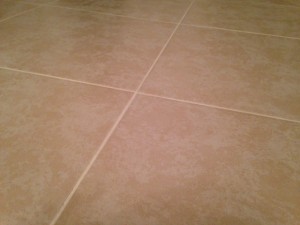Those of you who have read my blog the past couple of weeks know that I attended the International Surface Event in Las Vegas last week. Our company presented a class, but I also attended other interesting lectures as well.
When I heard there was a lecture on grout, I just had to go. You’re probably wondering why a person in the stone restoration industry would be so interested in grout. Well, I’ll tell you why: I get asked all the time why grout lines look so dirty? It’s not just building property managers asking me; it’s homeowners too. When it comes to the grout lines between marble tiles or ceramic tiles, it’s important to be informed on what grout is best and what are the best methods to take care of grout.
Last Monday, I attended “Grout: Your Choice Really Matters” (MO07). I went into class knowing the difference between cement grout and epoxy grout, but I learned that there are a lot more options when it comes to picking types of grout.
I think it is fairly well known that cement grout stains more easily than epoxy grout, which is why it is so important to seal cement grout at least one time per year with a penetrating sealer, like Seal & Go® S.
Now, if you have an epoxy grout, you do not need to seal your grout lines, but remember that even epoxy grout is not bullet proof. Like cement grout, you need to use mild cleaners to clean grout lines. Overtime, certain really strong cleaners (if overused) can break down epoxy grout.
So let’s delve more into other types of grout choices we have other than cement and epoxy; ever heard of pre-mixed grouts before? I certainly hadn’t before this class. Pre-mixed grouts can be mixed with either acrylics or urethane. These grouts may hold up better than epoxy grouts and some can even resist mildew.
However, if you don’t have the budget for pre-mixed grouts or epoxy grouts (which can be 10-20% more expensive than cement grout), let me propose another suggestion: instead of using cement grout A118.6 why not try A118.7? It’s not a huge difference in price, but that small switch to A118.7 and you have a higher performance grout. It may not be top of the line, but it is an improvement. (Note: Check with the manufacturer to see if specific brands of A118.7 can be used with natural stone tiles.)
What it all boils down to is this: you need to determine which grout is right for you based on your budget, the grout’s “clean-ability,” the grout’s stain resistance, and the grout’s crack resistance.
Also remember that maintenance is a huge factor when it comes to grout performance. If you are interested in products to clean your grout, check out MDR (Mineral Deposit Remover) and TGR (Tile and Grout Restorer). If you have a marble, travertine, or limestone floor, you should stick to neutral cleaners such as Lavenet or Lavenet Green.


1 Response
1 Pingback
[…] To find out more information about the various grouts, click here. […]